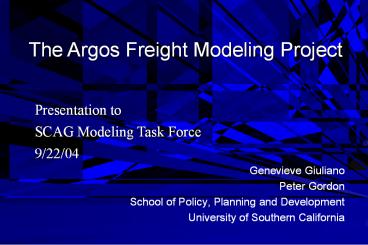The Argos Freight Modeling Project PowerPoint PPT Presentation
1 / 14
Title: The Argos Freight Modeling Project
1
The Argos Freight Modeling Project
Presentation to SCAG Modeling Task Force 9/22/04
Genevieve Giuliano Peter Gordon School of Policy,
Planning and Development University of Southern
California
2
The Argos Research Project
Purpose Develop an intra-metropolitan freight
flow model using state of the art computer
science techniques
3
Argos Project Goals
- Contribute to knowledge in both information
science and social science - Address a significant government problem
- Conduct interdisciplinary research that bridges
information science and social science
4
The Intra-metropolitan Freight Flow Estimation
Problem
- Models
- Goods movement as inter-regional trade problem
- Many good models of inter-regional freight flows
- High level of aggregation in geography,
commodities - Dont translate easily to intra-metropolitan
context - State-of-practice transportation planning models
- Conventional urban models do not take freight
directly into account - Traditional 4-step approach difficult to apply to
freight - Differences in behavioral foundations of travel
demand - Variation in supply/demand across industry
sectors - Changing industry dynamics
5
Problems, cont
- Data
- Extensive data requirements
- Flows by mode, commodity, value, origin
destination - Lack of disaggregate data
- US, state level data generally available county
and smaller unit limited - Fine geography does not coincide with fine sector
data - Proprietary data
- Private firms not required to release data
- Customs data processed by third parties
- Black box nature
- Survey data
- Infrequent, costly to update
6
An Ideal Model Would
- have solid behavioral foundation
- be multi-modal
- handle passenger and freight trip interactions
- minimize use of costly data
- be easily updated
- be transferable
7
Our Approach
- Use accessible, reliable data sources
- Available to public
- Regular updates
- Transparent computations
- Produced by reliable sources
- Use economic supply/demand as model foundation
- Use as much detail as possible
- Geography
- Economic sectors
8
Basic Concepts of Model
- Freight supply/demand in two basic categories
- Intra-regional supply/demand within SCAG region
- Inter-regional imports to, exports from,
pass-through flows - Intra-regional supply/demand
- Use IMPLAN I/O model for region
- Factor out imports/exports
- Inter-regional supply/demand
- Use import/export data sources (by mode)
- Identify import/export zones/nodes
- Use regional employment as control total
9
Main Data Sources
10
INTRA-REGION
IMPORTS/EXPORTS
WCUS 2000
SCAG SURVEY
I-O TABLE 2001
AIRPORT DATA
ITMS
SCAG 2000 EMP
LINKS TO IMPORT, EXPORT NODES
AGGREGATE SECTORS
CONVERSION TO COMPATIBLE SECTOR, /TON VALUES
CHECK
ATTRACTIONS PRODUCTIONS (, JOBS, by TAZ)
COMBINE INTER AND INTRA P A
FREIGHT FLOW MODEL STEPS IN GENERATING FREIGHT
SUPPLY/DEMAND
CHECK
AGGREGATE TO REGIONAL TOTALS
GO TO TRANSPORTATION MODEL
11
SOME DETAILS ON INTRA-METRO PORTION
SCAG 2000 EMP DATA Employment by sector, TAZ
IMPLAN 2001 I/O Regional transactions table
Check/adjust to sector, county totals
Apply sector IO coefficients to employment data
Generate supply, demand by TAZ, sector in jobs,
12
SOME DETAILS ON FREIGHT TRANSPORTATION MODEL
N x N matrix of freight Ps, As in tons
Factor out air, water, rail
Generate O-D matrix using gravity-type
distribution model
SCAG region transportation network with
equilibrium passenger traffic assignment
Convert O-D flows to PCEs
Traffic Assignment of freight PCEs
Equilibrium total traffic assignment
13
Workflow for Freight Estimation
14
Recent Work
- Update data sources to 2000, 2001
- Develop conversion table for sector codes (SIC,
NAICS, SITC, etc) - Seek better sources for ground imports/exports
- Seek better methods for /tons/jobs conversions
- Develop logical internal checks
- To learn more.http//www.isi.edu/argos

